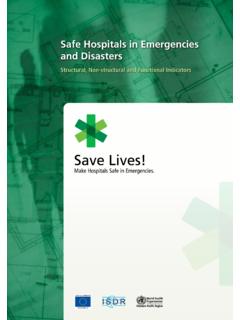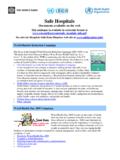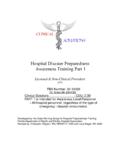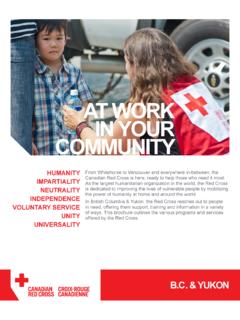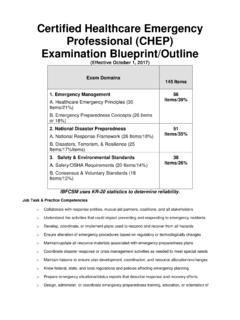Transcription of COMPREHENSIVE SAFE - WHO | World Health Organization
1 1 COMPREHENSIVE safe hospital FRAMEWORKHOSPITALCOMPREHENSIVESAFEFRAMEW ORKSAFE HOSPITALS INITIATIVE World Health Organization , 2015 All rights reserved. Publications of the World Health Organization are available on the WHO website ( ) or can be purchased from WHO Press, World Health Organization , 20 Avenue Appia, 1211 Geneva 27, Switzerland (tel.: +41 22 791 3264; fax: +41 22 791 4857; e-mail: for permission to reproduce or translate WHO publications whether for sale or for non-commercial distribution should be addressed to WHO Press through the WHO website ( ).The designations employed and the presentation of the material in this publication do not imply the expression of any opinion whatsoever on the part of the World Health Organization concerning the legal status of any country, territory, city or area or of its authorities, or concerning the delimitation of its frontiers or boundaries. Dotted and dashed lines on maps represent approximate border lines for which there may not yet be full mention of specific companies or of certain manufacturers products does not imply that they are endorsed or recommended by the World Health Organization in preference to others of a similar nature that are not mentioned.)
2 Errors and omissions excepted, the names of proprietary products are distinguished by initial capital reasonable precautions have been taken by the World Health Organization to verify the information contained in this publication. However, the published material is being distributed without warranty of any kind, either expressed or implied. The responsibility for the interpretation and use of the material lies with the reader. In no event shall the World Health Organization be liable for damages arising from its HQ/PEC/ERM/ credit: Paprika, Annecy-Le-Vieux, FrancePhotocredits;Cover : WHO/SEARO/P. Bagla; WHO/E. Simon; WHO/EMRO/C. Banluta; WHO/PAHO;Inside pages: WHO/S. Sarhan; WHO/SEARO /S. Rai; WHO/H. Ruiz; WHO/PAHO/V. Ariscain; WHO/SEARO/P. Bagla; WHO/ ; WHO/M-A. Heine; USGS; WHO/PAHO; WHO/C. safe hospital FRAMEWORKI safe HOSPITALS BACKGROUND AND JUSTIFICATION WHY safe HOSPITALS SHOULD BE A PRIORITYH ealth facilities, especially hospitals, are critical assets for communities both routinely and especially in response to emergencies, disasters and other crises.
3 Yet hospitals and Health workers are often among the major casualties of emergencies, with the result that Health services cannot be provided to affected communities when they are most The vast investment in Health infrastructure - hospitals can absorb up to 70% of ministry of Health budgets - can be lost when poorly constructed hospitals are destroyed or damaged. Hospitals are also important symbols of social well-being. Destruction of or damage to a hospital may result in a loss of trust in local authorities as well as exposing patients and Health workers to further vulnerabilities. Acts of violence, including direct attacks, have increased the threats to the security of hospitals, Health workers, patients and Health services. Measures to ensure the safety, security and functionality of Health infrastructure are needed at both national and community levels.
4 Countries and communities need to prioritize the protection of new and existing hospitals and other Health facilities from identified hazards and should ensure the physical integrity of buildings, equipment and critical hospital systems. In addition, they should provide for the security and well-being of Health workers and patients, and should ensure that hospitals are able to continue to function and provide life-saving services in the immediate response to emergencies and in their aftermath. Hospitals can be made more resilient and functional through action to improve the environmental sustainability of Health infrastructure, including measures to increase the reliability of power and water supply systems and to reduce harmful waste. A safe hospital programme is an essential component of a country s strategy for disaster risk reduction and, in particular, emergency and disaster risk management for the context of this framework, safe hospital refers to all types of Health facilities and their functionalities.
5 safe hospital is a widely used term, but this framework takes into account the critical roles that different types of Health facilities play in ensuring a safer Health system including Health centres, laboratories, clinics (including those that provide prevention services and Health promotion), small and medium-sized hospitals, and referral hospitals. 70%of ministry of Health budgets are absorbed by hospitals. Investments in hospitals must be protected from damage and The scale of damage to Health facilities ranges from a single critical hospital to many Health facilities. In September 2009, floods caused the evacuation of patients and shut-down of critical services in Burkina Faso s main hospital in the capital Ouagadougou. National and local Health systems that provide Health services for millions of people have been affected by damage to and destruction of thousands of Health facilities in Gujarat, India (2001), in Indonesia s northern Aceh province (2004), in Pakistan (2005) and in Myanmar (2008).
6 More than 11 000 Health facilities were damaged or destroyed by the earthquake that struck China on 12 May 2008. Some 432 Health facilities were damaged by Typhoon Haiyan in the Philippines in 2013, including 296 barangay Health stations, 97 rural Health units, 38 hospitals and the Eastern Visayas regional office of the Department of Health . The total cost of damage to Health facilities was estimated at approximately US$ 26 million ( , accessed 30 December 2014). During the three-week Gaza Strip emergency in 2008-2009, 16 Health staff were killed and 25 injured while on duty, and 15 hospitals, 41 primary Health centres and 29 ambulances were safe hospital FRAMEWORK PROGRESS TO DATEG overnment agencies (including ministries of Health and national disaster management authorities), public and private hospitals and their partners have taken action to ensure the safety and preparedness of hospitals so that they can continue to deliver essential services in emergencies and disasters.
7 Seventy-seven countries across the World have reported that they are implementing safe hospital activities. WHO and partners have been promoting safe hospital programmes for over 20 years through global, regional and national policy commitments, technical guidance and support to countries and partner organizations in WHO s six The safety and preparedness of over 3500 Health facilities have been assessed and action has been taken to implement recommendations to make hospitals safer and better prepared for emergencies. Many training programmes have been conducted to increase the capacity of hospital staff to prepare for and respond to internal and external developments that are aligned with safe Hospitals have included a greater focus on security measures to protect Health workers and facilities in areas of conflict, violence and criminality, and initiatives to improve the energy efficiency and waste management practices of green or smart hospitals.
8 The Hyogo Framework for Action 2005 2015 makes specific reference to promot[ing] the goal of hospitals safe from disaster by ensuring that all new hospitals are built with a level of resilience that strengthens their capacity to remain functional in disaster situations and implement mitigation measures to reinforce existing Health facilities, particularly those providing primary Health care . The World Health Assembly and WHO Regional Committees have passed resolutions3 with member states pledging to make their hospitals continued focus on safe hospitals was recognized in the Communiqu of the High Level Dialogue of the Global Platform for Disaster Risk Reduction in May 2013 which proposed to all stakeholders to rally behind: .. a global safe schools and safe Health structures campaign in disaster-prone areas with voluntary funding and commitments to be announced at the World Conference for Disaster Risk Reduction for 2015.
9 This COMPREHENSIVE safe hospital framework is intended to guide global and national actions for implementing safe hospitals as a major priority in the post-2015 framework on disaster risk reduction (DRR) and in country and community strategies for DRR. CHALLENGESMany countries vulnerable to disasters have implemented actions that include assessment of hospitals and Health facilities, retrofitting of key hospitals to strengthen their levels of resilience, implementing hospital safety systems through plans, capacity-building and exercises, and planning for more resilient Health infrastructure. The actions have been driven primarily by the risk factors in the different countries, with national priorities focusing variously on physical safety of hospital buildings, improved preparedness of hospitals and Health systems, and post-disaster reconstruction of hospitals to build back better. However, these efforts have been sporadic and insufficiently integrated into government plans for development and emergency response.
10 Many challenges remain, especially for countries with limited resources and facing high risks of emergencies. Making hospitals safer requires countries to construct facilities to withstand future hazards (including the risks of climate change), provide security for staff and patients, and ensure they are prepared to respond to and recover from the effects of emergencies, disasters and other crises. While assessments of the safety of existing facilities have been conducted, there is a need to ensure that the human and financial resources are available to implement the recommendations of the assessments, including retrofitting of 2 For example: World Health Day 2009; Hospitals safe from Disasters (UNISDR/ World Bank/WHO World Disaster Reduction campaign 2008-2009); One Million safe Schools and Hospitals campaign ( , accessed 30 December 2014).3 Resolution Strengthening national Health emergency and disaster management capacities and resilience of Health systems.










